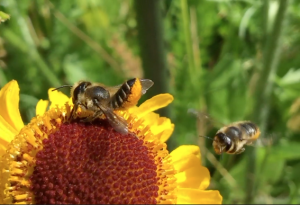Do female solitary bees give ‘hands-off’ signals to harassing males?
Female solitary bees are accosted by males especially if they believe her to be receptive. Fertilised females are very busy with the physical and time demands of collecting pollen or other materials to provision or build their nests. It would be beneficial for them if they could be left alone and free from male harassment.
A wasteful time or loss of nesting materials?
Males, only need to tank-up on nectar, for their mating activities ahead. Females, on the other hand, besides foraging for their own needs have to seek out a nest site, construct cells, provision them, lay eggs and seal the cells. Far more time and energy-consuming. They also have to repel males, as seen in the video. Whenever a male bee grapples with a female, she could lose valuable pollen, nest materials, or she has to flee in a hurry. Wrestling with males, even momentarily, could increase the wear and tear on her body and wings. In some cases, as such the hairy-footed flower bee, Anthomphora plumipes, females are often knocked to the ground by males. They respond by taking evasive flight and physical repulsion and a more general change in foraging behaviour. Stone states that male harassment halved the rate of reward for females who moved elsewhere to forage. Such unwarranted male bee attention would lead them to make less foraging trips, unable to make efficient use of time for nest building and spending more time overall in their nest construction.
Leafcutter bee pointing pollen-laden scopa skywards quite often, particularly with female leafcutter bees, watch them deliberately point their pollen-laden abdomens towards the sky. After a few seconds, they would lower it. What was the point of such a deliberate action? It may be that they would not brush their pollen load against petals, anthers, stigmas, etc., on the flower and lose some of their precious pollen, particularly when they are nectar-feeding and not pollen gathering. That would be wasteful both in time and energy in the collection and then recollecting its replacement.
Give him a sign
Without some physical signal, stating she is unreceptive, and seen by distant males, it is highly likely females will be accosted by a male bee. Therefore he would be wasting both of their time and energy?
No pollen, male investigates
In the video, I noticed the female, likely blue mason bee, Osmia caerulescens, nectar-feeding on yellow toadflax, her tongue extended during flight. The flowers are quite difficult to enter, and she has to force her way between the petals. She was pollen-free, a sensible precaution as she may lose some of it forcing her way past the petals to reach the nectar. It was during this bout of nectar-feeding, a male seeing she was pollen-free and therefore game to chance a coupling, flew and grappled with her. She repelled his advances and flew away having her feeding session disturbed on a favourable forage resource.
Pollen laden female display to male?
Whereas in the photograph above (and the video), the female leafcutter bee, (Megachile centuncularis?), whenever males were flying around her, she deliberately displayed her pollen-laden scopa by pointing it upwards. I have often seen this behaviour. Then they would lower it. So besides this deliberate action of protecting pollen from being displaced, I suspect this is probably a conscious effort to ward off any male harassment, “Leave me alone I am unreceptive and nest building!”. Of course, this would also help to prevent pollen from being scraped off her scopa whilst foraging, especially if she is about to be pounced upon by a male!
Similar behaviour from another solitary bee
Female solitary bees, Macropis nuda, while foraging for nectar or pollen, outstretch their pollen-laden hind legs, above their abdomens in direct response to a male’s mating pounce. This effectively dislodged the male but it can then communicate to other males “Leave me alone I am unreceptive and nest building!”. Why not a similar communication for leafcutter bees?
I have watched the abdomen pointing behaviour several times and not seen the males grapple with the females who displayed in this way. I have not noticed this behaviour with Red mason bees, but will look for it now! Sometimes you see an action but don’t take notice of what you are seeing!! As one of my old tutors stated, “Observation is being able to note with attention!”
Interested in Citizen Science and pollinators? The Buzz Club
For more information about solitary bees visit BWARS
For info and link to buy an excellent book Field Guide to the Bees of Great Britain and Ireland by Steven Falk
An extremely useful resource supports this book by a special web site feature within Steve Falk’s Flickr web site which furnishes extra photos and other useful resources to assist with identification.
With thanks to Jim Cane, USDA-ARS Pollinating Insect Research Unit, who prompted me to revisit some old films I made!!



Recent Comments